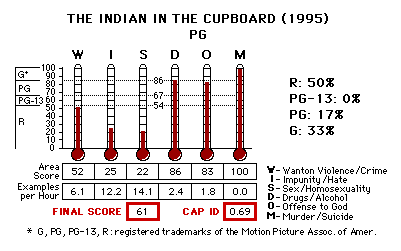a son pushing his mother while at the top of a small
staircase while talking with someone
quick movement to prevent parental discovery
ten additional occurences of the three/four letter word vocabulary
unauthorized exchange (theft)
taking parent's things without asking
nineteen examples of exposure of too much flesh, one of which was a flash of a bare posterior
death, implied to be the fault of a child
a lie to hide planned activity
| bully tactics/theft
drunkenness and talk of drinking/needing drink, suggestion of alcohol as medicine
two occurences of the use of God's name in vain without the four letter expletive
an exchange of gunfire/arrow barrage
an adolescent watching MTV
bloody injuries
argumentiveness against school authority and each other
making a mess with no concern for the work created for others
|
 The Indian in the Cupboard (1995) was a most difficult movie to justify. It was clearly a movie written for children but in it was much programming to lower the threshold of acceptability at a younger and younger age and to increase desensitization to what used to be unacceptable behavior. For example, this movie presented nineteen scenes of exposure of what has been traditionally too much posterior flesh and frontal flesh between the beltline and the thigh. Granted, the American Indians wore outfits similar to the outfit worn by Little Bear in this movie, but if the amount of exposure of his flesh was not a deliberate attempt to show as much skin as the producers thought they could get away with, then why did Little Bear the man not wear as much clothing as Little Bear the figurine? The Greecians and the Corinthians did things even now unacceptable but does that excuse presenting such behavior to children in the name of entertainment?
The Indian in the Cupboard (1995) was a most difficult movie to justify. It was clearly a movie written for children but in it was much programming to lower the threshold of acceptability at a younger and younger age and to increase desensitization to what used to be unacceptable behavior. For example, this movie presented nineteen scenes of exposure of what has been traditionally too much posterior flesh and frontal flesh between the beltline and the thigh. Granted, the American Indians wore outfits similar to the outfit worn by Little Bear in this movie, but if the amount of exposure of his flesh was not a deliberate attempt to show as much skin as the producers thought they could get away with, then why did Little Bear the man not wear as much clothing as Little Bear the figurine? The Greecians and the Corinthians did things even now unacceptable but does that excuse presenting such behavior to children in the name of entertainment?